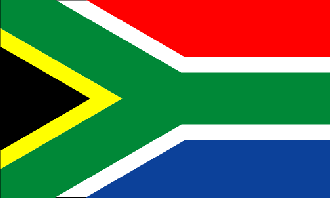
|
South Africa
Background:
After the British seized the Cape of Good Hope area in 1806, many of the Dutch
settlers (the Boers) trekked north to found their own republics. The discovery
of diamonds (1867) and gold (1886) spurred wealth and immigration and
intensified the subjugation of the native inhabitants. The Boers resisted
British encroachments, but were defeated in the Boer War (1899-1902). The
resulting Union of South Africa operated under a policy of apartheid - the
separate development of the races. The 1990s brought an end to apartheid
politically and ushered in black majority rule.
Location:
Southern Africa, at the southern tip of the continent of Africa.
Area: Total: 1,219,912 sq km, land: 1,219,912 sq km, note: includes Prince
Edward Islands (Marion Island and Prince Edward Island), water: 0 sq km.
Area - comparative: Slightly less than twice the size of Texas.
Land boundaries: Total: 4,862 km, border countries: Botswana 1,840 km, Lesotho
909 km, Mozambique 491 km, Namibia 967 km, Swaziland 430 km, Zimbabwe 225 km.
Coastline: 2,798 km.
Climate and Terrain:
Climate: Mostly semiarid; subtropical along east coast; sunny days, cool
nights.
Terrain: Vast interior plateau rimmed by rugged hills and narrow coastal plain.
People:
Population: 43,647,658.
Ethnic groups: Black 75.2%, white 13.6%, Colored 8.6%, Indian 2.6%.
Religions: Christian 68% (includes most whites and Coloreds, about 60% of
blacks and about 40% of Indians), Muslim 2%, Hindu 1.5% (60% of Indians),
indigenous beliefs and animist 28.5%.
Languages: 11 official languages, including Afrikaans, English, Ndebele, Pedi,
Sotho, Swazi, Tsonga, Tswana, Venda, Xhosa, Zulu.
Government:
Government type: Republic.
Capital: Pretoria; note - Cape Town is the legislative center and Bloemfontein
the judicial center.
Independence: 31 May 1910 (from UK).
Economy overview:
South Africa is a middle-income, developing country with an abundant supply of
resources, well-developed financial, legal, communications, energy, and
transport sectors, a stock exchange that ranks among the 10 largest in the
world, and a modern infrastructure supporting an efficient distribution of
goods to major urban centers throughout the region. However, growth has not
been strong enough to cut into high unemployment, and daunting economic
problems remain from the apartheid era, especially the problems of poverty and
lack of economic empowerment among the disadvantaged groups.
Statistics:
Telephones - main lines in use: More than 5 million.
Telephones - mobile cellular: 7.06 million.
Radio broadcast stations: AM 14, FM 347 (plus 243 repeaters), shortwave 1.
Radios: 17 million.
Television broadcast stations: 556 (plus 144 network repeaters).
Televisions: 6 million.
Internet users: 2.4 million.
Railways: Total: 20,384 km.
Highways: Total: 358,596 km, paved: 59,753 km, unpaved: 298,843 km.
Airports: with paved runways: 144, with unpaved runways: 596.
Return to Visiting Locations
|

